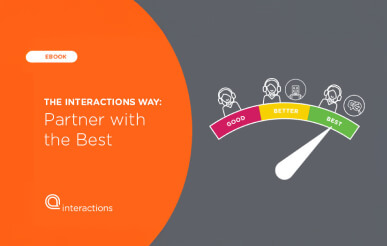The Chief Technology Officer (CTO) is often the driving force behind digital transformation. They’re the leader given the seemingly impossible task of determining strategic priorities of a brand from a technology perspective. They empower their teams, and the company as a whole, to create a brand culture that embraces innovation designed to improve revenue streams and operational efficiency.
For years, AI has been a hot topic for CTOs. But it wasn’t until recently that AI has transitioned from being a ‘science experiment’ or a proof of concept to a technology that is worthy of full IT budgets and resources. We now know that AI has the potential to transform a company’s performance. Early adopters have reaped the benefits. The laggards in AI adoption have failed to innovate and run the risk of ultimately failing their customers.
A CTO’s Role in Improving CX
In a recent study we conducted with Harris Poll, we found that 89% of individuals expect the use of AI across their company to increase over the next 2-3 years. Nearly everyone believes that the prevalence and importance of AI will ramp up for the companies they work for, regardless of role or industry. Despite its broad application, AI for customer experience, specifically Conversational AI, seems to be the place that many CTOs kick off their digital transformation journey.
According to McKinsey, over 60% of digital transformation projects are focused on improvements to customer experience, engagement and retention. What is that? Well, it’s because focusing on the happiness of customers ends up earning and saving a company money. In a highly competitive market, brands often compete on the basis of CX alone. Customers often attrite after a single poor experience! It’s worthwhile to focus on deploying technologies that support CX both financially and for the longevity of your brand. Conversational AI has revolutionized the way that customers communicate and interact with their favorite brands. In today’s age, Conversational AI deployed as Intelligent Virtual Assistants (IVAs) could be the gold standard for transformative technology.
The Age-Old Debate: DIY vs. a Conversational AI Partner
Knowing that Conversational AI is a technical priority is the first of many hurdles for a CTO. A major decision lies in whether a company will decide to build and deploy a Conversational AI solution internally, also referred to as DIY, or if they will partner with a vendor that specializes in Conversational AI solutions. “DIY vs. Partner” is common debate and the CTO of an organization is often the final decision maker. Because AI is a priority for many companies, CTOs are left feeling as though their teams should handle the development, deployment, and maintenance of a Conversational AI solution in-house. The complexity, resources required, and constant training and tuning of an IVA can be overwhelming and would eventually become the core focus of an IT organization.
Here are a few things for CTO’s to reflect on as they embark on the decision on whether to build in-house, or partner with a Conversational AI expert:
- Conversational AI is not one technology; it’s a synchronized array of many underlying technologies such as ASR, NLP, Dialog Management, Machine Learning etc.
- Conversational AI needs many experts to build, train, implement and maintain – only app developers are not sufficient to build AI solutions.
- Without advanced conversational design expertise AI deployments seem clunky and robotic, leading to undesirable customer experience.
- AI systems need constant training and tuning. Typical ‘set it and forget it’ deployment approach doesn’t work for AI.
- Deep domain knowledge is essential. Building a Conversational AI solution for customer care requires a deep domain knowledge about the contact center and the customer experience industry.
Partnering with a Conversational AI provider that is also a fully managed service means that a CTO will no longer have the stress of leading the entire implementation process. A partner will have deep domain expertise, leaving a tech organization to focus on their own core competencies without having to manage the competing priorities associated with balancing an AI project and the many other projects that IT manages.
To learn more to support a DIY vs. Conversational AI partner decision, watch this short video.
Building the Right Conversational AI Committee
In a recent study, we found that IT organizations are involved in 90% of all AI decisions. While determining whether or not Conversational AI fits into the strategic roadmap for a technical team is essential, it’s also important to incorporate the voices and perspectives of other leaders within an organization. CTO can lead the discussion and set a tone of innovation and disruption, but it’s essential to have the buy-in from Customer Success, Marketing, Contact Center Leadership, and Finance. Each group will have different requirements and needs. Early collaboration will drive a better end solution. For example, while a CTO has full visibility into the needed integrations into CRMs and other backend systems required to drive personalization, Contact Center leadership may have their own insight into common customer inquiries that could be a great place to kick off automation.
Creating a Rollout Plan
Once the right team is assembled, the next step is putting together a rollout plan that makes sense for both your technical and business teams and your customers. This requires having a clear understanding of the right transactions to automate first, and what transactions can wait until phrase 2 or 3 of a rollout plan. Knowing the most appropriate starting place and clearly articulating the expected benefits will drive better acceptance and adoption throughout your organization.
Embarking on a digital transformation journey is no easy feat. The planning, execution, and results often fall in the hands of a CTO (and for good reason). CTOs best understand the complexity of these applications and are well-suited to making decisions that will support the organization for years to come. Selecting crafting the right game plan and executing it with a well-vetted partner is often the best path forward and guarantees a successful implementation of a Conversational AI solution.




